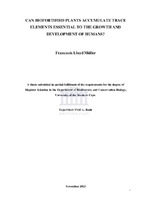| dc.description.abstract | Micronutrient and trace element deficiencies are a problem affecting nearly two billion
people globally. The people affected the most by these deficiencies are those living in poor
and rural communities in the developing countries and thus cannot always afford the
diverse diet as advocated by WHO and the FAO. Millions of these people living in the
poor and developing countries die yearly, either directly or indirectly, as a result of
micronutrient and trace element deficiencies. Thus, this study aimed to determine the
nutrient content (Co, Cr, F, I, Se and V) of various vegetable based food items collected
from the Cape Town area in the Western Cape Province of South Africa. This was done to
determine which vegetable crops provided the highest concentrations of essential trace
elements, and how much they contribute to the daily recommended intake (DRIs) of these
trace elements. It also aimed to assess the effects of the addition of the trace elements (Co,
Cr, F, I, Se, Si, Sn and V) on seed germination and root growth under controlled
conditions in order to calculate their phytotoxicity, and then to biofortify four vegetable
crop species, grown in sand culture, with a composite treatment of the trace elements to
determine how the addition of these elements will affect the vegetable crops grown under
these experimental conditions.
From this study, it was shown that trace element content in vegetable crops in the Western
Cape Province of South Africa varied between different geographic locations and that
certain trace elements were absent from several items collected from some areas. Although
some crop species contained sufficient amounts of certain trace elements to satisfy our
daily recommended intakes, most of the crops were found to contain insufficient amounts
of many of the trace elements to satisfy our needs. Leafy vegetables and tubers were
identified as the better vegetable types to biofortify with essential trace elements as they already contain higher concentrations of several of the essential trace elements and should
thus be assessed for their effectiveness as crops to be biofortified. When the trace elements
were applied directly to cress and lettuce seeds, it was found that all the trace elements, as
well as the composite treatments, exerted phytotoxic effects on cress and/or lettuce seeds
when applied at high concentrations. Lettuce was found to be more prone to the effects of
these elements. Seed germination was strongly inhibited by fluoride, while several
elements affected root growth. When fluoride was left out of the composite treatment,
phytotoxicity only occurred at high concentrations. The addition of the trace elements at
the high concentrations to already established spinach, cabbage, lettuce and turnip plants
were found to affect the uptake of several essential plant nutrients, but the concentrations
of the elements affected generally remained higher than the concentrations needed for
adequate growth of agricultural crops. Several of the trace elements supplied to the plants
were also found to be retained in the roots of the vegetable crops however, as the
concentrations supplied to the plants increased, so did the concentrations found in the
edible portions of the crops.
Agronomic biofortification of vegetable crops with simultaneous additions of multiple
trace elements, under these experimental conditions, was thus considered to be a viable
option to increase the concentrations of essential mineral nutrients in the edible portions of
vegetable crops. However, these modified nutrient fertilizers should only be given to
established crops or without the addition of fluoride. Further research on a wider variety of
seeds and vegetable crops, as well as research under field conditions is needed to
determine whether these findings remain relevant under these conditions. | en_US |

